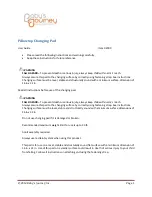
13
Balancing The Head
Make sure that the head is level before balancing. Check the bubble level to
verify that the head itself is level and make sure that the platform is also level.
NOTE: It is important that the handle(s) and all camera accessories (lens,
zoom and focus controls, viewfinder, prompter etc.) are fitted in their
operational position before balancing the head. Any equipment fitted or
adjusted later can unbalance the head.
Balancing the 2575D head achieves two objectives. First, when a head is
correctly balanced the operator will need a minimum amount of effort to move
the camera. Second, once balanced, the head and its payload can be set to
any tilt position and the head will maintain this position with ‘hands off’.
The chart below shows the range of load and C of G heights that can be
maintained in balance. The area under the balance curve (colored white)
corresponds to load/C of G combinations that can be balanced over the full tilt
range of ±90°. The area above the balance curve (shaded grey) corresponds
to load/C of G combinations that exceed the capacity of the head.
in
lbs
kg
mm
CAMERA WEIGHT
2575D COUNTERBALANCE
C
A
M
E
R
A
C
E
N
T
E
R
O
F
G
R
A
V
IT
Y
A
B
O
V
E
P
L
A
T
F
O
R
M
Fore And Aft Balance
1. When positioning the payload, it is important to be aware of the
potential danger that an unbalanced payload will fall away suddenly.
Always be prepared for this by maintaining a firm hold on the payload
until the balance is set correctly.
2. Make sure that the camera and all accessories are installed in their
operating positions.
3. Before disengaging the tilt lock pin, turn the Counterbalance crank to
set the counterbalance to 50%. Depending on the payload weight, it
Operator's Guide - OConnor 2575D Pan and Tilt Head
www.ocon.com
OConnor Engineering




































